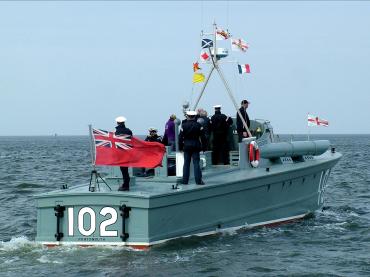Previous names
- Wild Chorus
Details
Construction
Dimensions
History
Built in 1939 by Vospers at Portsmouth, MTB 71 is a Motor Torpedo Boat with a hard chine hull of double diagonal mahogany planking. She is said to be the last wartime motor torpedo boat of her kind in existence. She was ordered by the Royal Norwegian Navy as their MTB 7, the keel having been laid down by Vosper at Portsmouth on 28 July 1939, but following the outbreak of war in September, she was requisitioned by the Admiralty. She was a 60-foot boat, armed with two 18-inch torpedos and twin machine-guns, and had Isotta-Fraschini engines. Completed on 2 July 1940, she joined the 11th MTB Flotilla at HMS Wasp, Dover. The flotilla's work included night-time anti- E-boat patrols and crash-boat duties (picking up 'ditched' fighter pilots and survivors from merchant ships sunk by the enemy). Two months later, during a heavy air attack on Dover, she was damaged, including a fire in her wheelhouse, and repairs at Whitstable took four months. In June 1941, she was slightly damaged in action with enemy escort vessels off Etaples and her petty officer stoker was killed. The next month, in further action off Berck buoy, she was holed below the waterline and was out of action for two months whilst under repair on the Thames. In November 1941, she re-commissioned with a Royal Norwegian Navy crew, to join the 1st MTB Flotilla at HMS Beehive, Felixstowe, and had a skirmish with E-boats off Kwinte Bank. In February 1942, she reverted to a RN crew and was involved in the Dover Straits, searching for the German Scharnhorst, Gneisenau and Prinz Eugen during their Channel dash on 12 February. MTB 71 was recorded as being damaged that day by shellfire and was then under repair at Brightlingsea for six months. In September 1942, she transferred to the 4th MTB Flotilla at Felixstowe and was in action off the Hook of Holland two months later. In June 1943, she was transferred to the Royal Army Service Corps and was laid up at Portsmouth and cannibalised for spares for her sister ship, MTB 72, which had also been taken over by the army. Then, in September 1944, she was returned to the navy at HMS Hornet, and sold the following year for use as a housebout, WILD CHORUS, at Birdham. Her owner died in 1992 and she was acquired by Hampshire County Council in conjunction with the MTB 71 Group Charitable Trust. She underwent partial restoration within Portsmouth Dockyard before being moved to the British Military Powerboat Trust's yard at Marchwood for further restoration as a static exhibit. In April 2005, she was taken to the Imperial War Museum's site at Duxford, Cambridgeshire, for display in a hangar. Source: Paul Brown, Historic Ships The Survivors (Amberley, 2010), updated Feb 2011.
Since Autumn 2021, the newly-restored coastal motor boat CMB331 and motor torpedo boat MTB71 have been on display at the National Museum of the Royal Navy’s (NMRN) Explosion Museum in Gosport as part of the exhibition The Night Hunters: The Royal Navy’s Coastal Forces At War which tells the story of the Royal Navy’s coastal forces from inception in August 1916 to their demise in the late 1950s.
Sources
North, A J D, Royal Naval Coastal Forces, Almark Publications, 1972
World Ship Society British Armed Forces Small Craft Historical Society, Survivors Register, 1998
The News (Portsmouth): Last of Line MTB set for Place in History, 1 June 1995
Own this vessel?
If you are the owner of this vessel and would like to provide more details or updated information, please contact info@nationalhistoricships.org.uk










